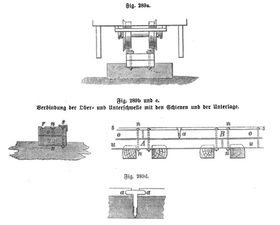Lo Presti monorail
The Lo-Presti monorail (historical name: Lo-Presti's railway system) was a railway system for the exploitation of forests.
functionality

In the railway system developed by the Hungarian engineer Baron Ludwig Lo-Presti, the principle of the narrow-gauge railway was implemented to the lowest permissible limit and beyond it. The entire superstructure of the Lo Presti Railway consisted of a single beam, which carried a flat rail on its upper surface on the left and right side edges. The track width therefore almost corresponded to the width of the upper surface of a wooden beam and was normally no more than 300-400 mm, since otherwise extremely valuable wood assortments would have had to be used, which would have increased the costs of building the railway.
Lo-Presti set up five classes of railways, which should have gauges of 878, 658.5, 434.6, 340.2 and 210.5 mm. Of these, however, only the classes with the gauge 134.6 and 340.2 were approved. For a track width of about 300 mm it was fairly easy to get wood around 1877, which is why it was considered the most important class of Lo Presti railways at that time.
Lo-Presti received permission from the Chamber of Albrecht von Österreich-Teschen to create a test route based on his system. In 1868 he built a railway on the domain in Teschen (Těšín). Government councilor Wilhelm Franz Exner from Vienna inspected the Lo-Presti Bahn in Grudek (Hrádek) and published the following data about the system:
- The width of the upper surface of the beam: 316 mm
- Height of the beam: 158 to 316 mm
- Length approx. 6 m
These beams or "track elements", as Lo-Presti called them, were mostly on the ground or on low supports made of wood or stone. The rails were 26.3 mm wide and 13.25 mm thick. The “Lowry” lorry for log transport usually transported up to 1½ tons (one fathom) and had a dead weight of 500 kg (10 Ctr.).
The substructure of the Lo Presti railway consisted either of the naturally grown, more or less leveled soil. If this did not work, the track units were placed on "appropriately prepared post pieces, blocks or stones that were as equidistant as possible and were usually not connected to the track." The individual track parts were connected to one another in a form-fitting manner.
Driving safety
Driving safety on the Lo Presti railways was reduced to a critical minimum. However, the operation of the Grudeker test track and theoretical considerations showed that the Lo Presti system could be used as a means of transport for logs, but according to Edmund Heusinger von Waldegg only under the following conditions:
- The track width could not be smaller than 300 mm.
- The rails should not have a smaller profile than the profile given above.
- The length of the track units could not be more than 4 m and not less than 300 mm in height if they were only supported at four points.
- The weight of a loaded wagon was not allowed to exceed 2 t (40 Ctr.).
- The speed was not allowed to exceed 10 km / h (3 m / s) in the bends.
- The radius of these arches was not allowed to drop below 8 m, especially where the track lay on cross sleepers.
- Complicated railway construction objects and all other proposals published by Lo-Presti were to be avoided.
- The inclination of the orbit plane could not be more than 50 mm per meter on average, and should only rarely reach the maximum of 80 mm per meter.
- The system required a powerful, safe brake for the car.
- Operation by locomotives was not possible.
The Grudeker Bahn wagon was significantly less stable than conventional narrow-gauge wagons. The last-mentioned condition regarding locomotive operation, which Heusinger had already established in 1868, actually proved to be completely justified after the test drives which Lo-Presti undertook with locomotives on Hungarian railways of his system should have led to a complete fiasco.
The system could at least be used in certain cases, namely for the exploitation of forests.
See also
- Addis monorail
- Aldershot Narrow Gauge Suspension Railway
- Caillet monorail
- Ewing monorail
- Larmanyat monorail
- Lartigue monorail
- Wiesenburg monorail
Individual evidence
- ↑ Karl Schuberg : The forest road construction and its preparatory work - the construction work, cost estimates and the total construction in economic operations. Springer-Verlag, Heidelberg, 1875. Second volume, pp. 501–502.
- ↑ Alexander von Engel: Oesterreichs Holzindustrie und Holzhandel: A monograph… W. Frick, 1907. P. 151.
- ^ Edmund Heusinger von Waldegg : Handbook for special railway technology. 1878. Fifth volume, pp. 526-527 (see also reprint from 2020. ISBN 978-3-84604-840-5 ).
- ^ Wilhelm Franz Exner : Modern transport in the service of agriculture and forestry. Weimar, 1877.

